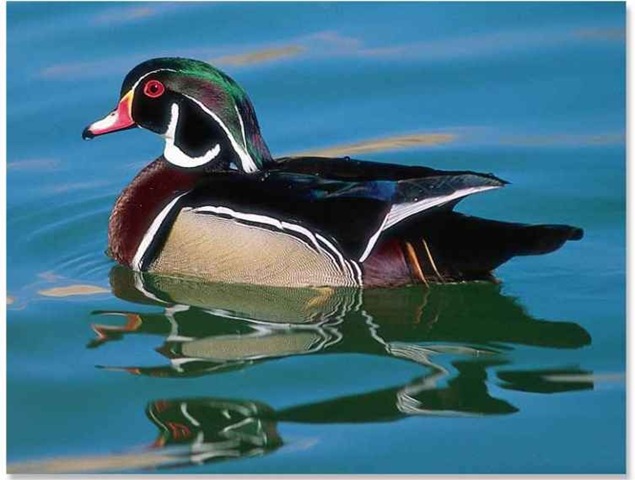ORDER
Anseriformes
FAMILY
Anatidae
GENUS & SPECIES
key features
• A true North American bird, the wood duck occurs naturally on no other continent
• Striking colors of the drake (male) make it one of the most beautiful of all birds
• Nests in tree holes and man-made tree boxes, unlike most ducks
where in the world?
occurs only in North America, in mainland U.S. and southern Canada; northern populations fly south to winter in Mexico; small population in Cuba
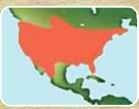
LIFECYCLE
Of all North American waterfowl, the wood duck is the most adept at living in thickly forested wetlands, thriving in a habitat that provides nest sites, food and cover.
HABITAT
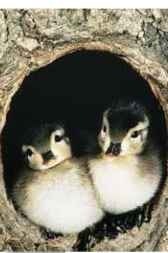
A wooded high-rise The wood duck nests in trees as high as 50′.
The wood duck flourishes in freshwater; preferring bodies that are slow-moving and shallow. It frequents areas sheltered by dense stands of trees and shrubs, with just enough sunlight breaking through to support an abundant food supply.The wood duck can adapt to almost every type of freshwater wetland — rivers, streams; lakes; ponds; swamps and even the numerous shallow, wooded ponds created by beavers. Flocks navigate deftly through the thick branches of lowland hardwoods. These sites are sometimes close to human habitation, and conservationists build nest houses for the ducks. Occasionally, wood ducks even try to nest in structures such as barns or chimneys.
Watery home The wood duck is a dabbling duck, at home in the water.
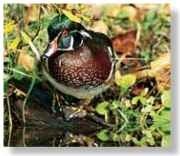
The wood duck’s love for acorns earned it the name the “acorn duck.”
The female lays 10-16
eggs, the largest number of any North American bird.
Native Americans revered wood ducks — their image adorns ceremonial items.
The wood duck can run over 7 mph, faster than any other duck species.
FOOD & FEEDING
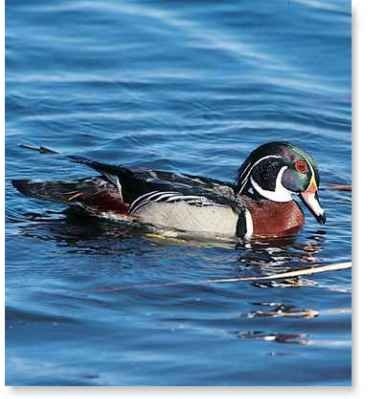
Wood ducks are omnivorous, consuming a wide variety of plants and animals, with acorns being their preferred food. Small fish and insects are an especially important source of protein to breeding females and ducklings. Wood ducks do not establish or defend feeding territories. They feed in small groups and cover sizable areas while searching for food. Although wood ducks feed most often in and under the water, they often forage for insects, fruits and grains on dry land. During the nesting period, the drake, having already eaten, will watch for danger while his mate feeds.
CONSERVATION
The wood duck population in North America is a strong 7-8 million birds, but this has not always been the case. Hunted dangerously close to extinction in the 1800s, it has made a remarkable comeback after being the only duck singled out for total protection under the Migrating Bird Treaty Act of 1918. Hunting is still regulated, but habitat loss is now a threat.
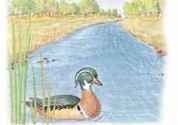
Searching…
The wood duck feeds most often in shallow waters, dabbling and probing for acorns, seeds, plants and insects.
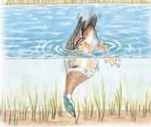
Tipping up…
When foods are too deep to reach, the duck dives by leaping up and forward and propelling into a tight arc with its feet.
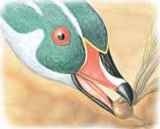
Tug of war…
With its hooked and narrow bill, the wood duck uproots tubers of aquatic plants, such as duck potato and water lilies.
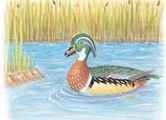
Torn to pieces
Because its bill is not adapted for crushing, items too large to be swallowed whole will have to be nibbled and torn.
BREEDING
Perfect duo
Wood ducks form a strong, monogamous bond.
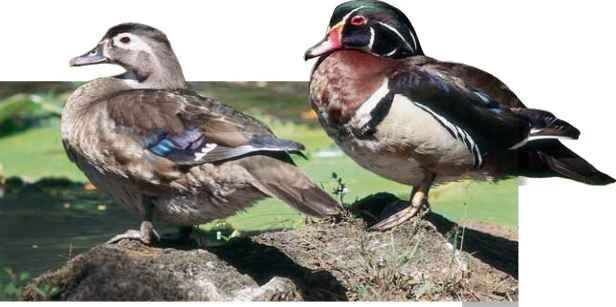
BEHAVIOR
A bird of quiet ponds and dark forests, the wood duck is shy and secretive, seeking refuge in the trees. An acrobatic flyer; it is just as agile in the water or even on land. The duck is a strong swimmer spending much of its time dabbling on the water’s surface. It also is one of the fastest ducks on land and will consistently outrace other species, such as mallards.The migration patterns of the wood duck are unique: it is the only species of North American waterfowl with a northern population (about two-thirds) that migrates and a significant southerly portion (about one-third) that doesn’t.
On the move
The wood duck drake takes off from the water almost vertically to fly swift and direct
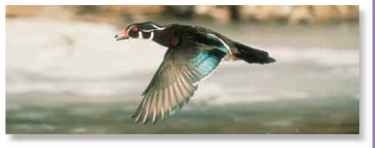
At least 6-7 months before the spring nesting season, large flocks of drakes gather for ritualized displays and vocalizations meant to impress females. The female will choose a mate and, once paired, they begin to search for a nest site.The final decision on a particular nest is made by the female alone. Rarely does a drake enter a nest hole, but he does stand guard in a nearby tree. The female incubates the eggs, covering them with downy feathers that she pulls or sheds from her breast.
The eggs hatch in about 30 days and, within just a few hours, the ducklings are capable of leaving the nest. The female scouts the surroundings, and when all is clear, she summons her brood from the nest. Hearing her soft call, the ducklings scramble out of the nest hole; one by one, they jump down to join her, using their tiny wings as parachutes to soften their fall.
PROFILE
Wood Duck
The striking, myriad colors in the plumage of the wood duck drake provide perfect camouflage in the shadowed forests and sunlit wetlands.
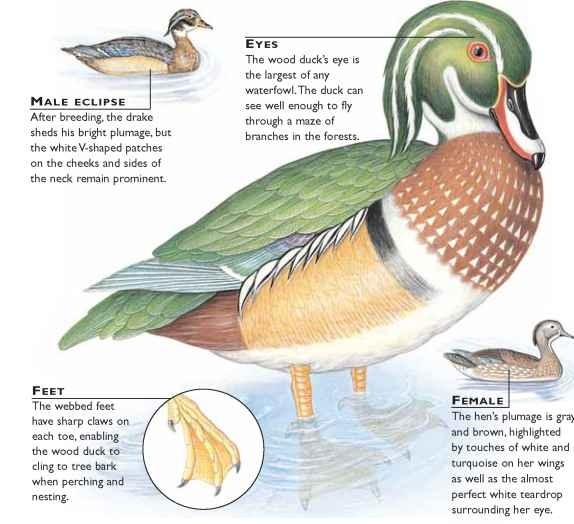
CREATURE COMPARISONS
Like the wood duck, the African pygmy goose (Nettapus auritus) is a woodland duck
that nests in tree holes. At 13″ long, this perching duck is one of the smallest ducks in the world and is found exclusively in Africa. Like the wood duck drake, the African pygmy goose drake has ornate coloring, with extensive iridescent colors of dark green and bright orange, a white face and a white collar.The female African pygmy goose is brownish with a plain, dusky head.
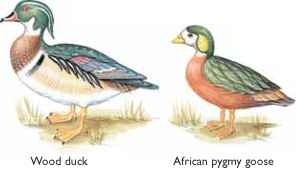
| vital statistics Weight 1.5 lbs. |
|
| Length | About 18″ |
| Wingspan | 2.5′ |
| Sexual Maturity | 1 year |
| Breeding Season | Spring in the north; spring.’ ‘ and fall in the south |
| Number of Eggs | 10-16 |
| Incubation Period | 28-33 days |
| Fledging Period | 8-10 weeks |
| BREEDING Interval | Up to 1 year |
| Typical Diet | Nuts, seeds, frogs, fish, insects and aquatic plants |
| Lifespan | 2- 6 years |
Related species
• The wood duck is one of only two species in the genus Aix. The other is the mandarin duck, A. galericulata, a native of Asia. These two cousins I belong to the Cairinini tribe, which contains 9 genera and 13 species of perching ducks and geese, including the muscovy duck, Cairina moschata, of Central and South America. All exhibit perching and tree-hole nesting traits.
